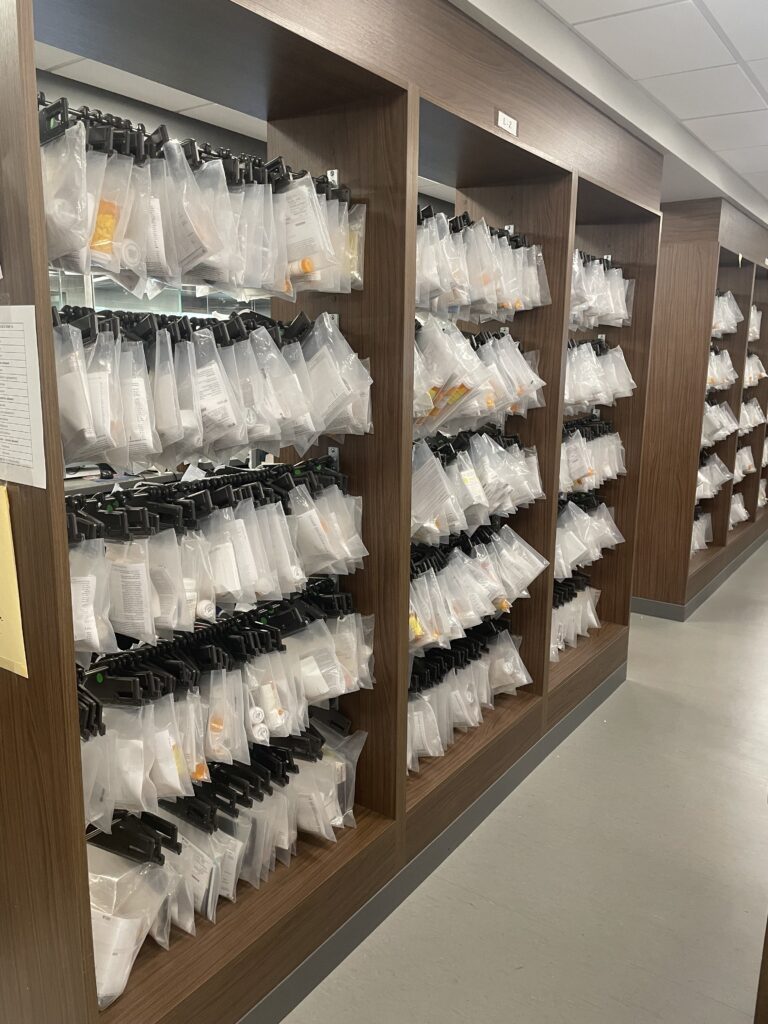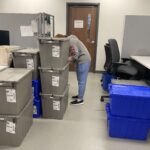Nebraska Medicine’s Durham Outpatient Center has 50% fewer employees in the pharmacy but hundreds more prescriptions in will call. And they’re managing better than ever. Here’s how:
Creating Central Fill
The Nebraska Medicine team knew they needed to find a way to improve collaboration, accommodate higher volumes across four outpatient pharmacies, and free up pharmacy teams to spend more time on patient care. Their “HUB” facility, including a Central Fill automation room and other centralized services has been fully operational five days a week since February 2023.
To learn about that decision and how implementation went, check out an earlier case study: Nebraska Medicine Sets Up Central Fill.
We caught up with Alyssa Lynam, PharmD, pharmacy supervisor at the Nebraska Medicine Durham Outpatient Pharmacy (DOC), and Amanda Haynie, PharmD, pharmacy supervisor at the Nebraska Medicine HUB Automation Room (HUB), to see how things are going nine months later.
Finding a Rhythm
This time last year, the Nebraska Medicine Durham Outpatient Center (DOC) pharmacy was dispensing an average of 1,300 prescriptions each weekday on site. Now, they average roughly 1,700 fills per day – and approximately 57% of those are done at the HUB automation facility.
The pharmacy team is able to dispense 100 prescriptions per hour on site at the DOC; they’re filling 140 prescriptions per hour at the HUB – and are capable of doing 250 per hour on the current automation line, should they need to.
The process works like this:
- At the HUB:
- Receive e-prescriptions, pre-verify and process claims
- Fill approximately half of prescription orders from one of two Parata Max robots; less frequently prescribed drugs or controlled substances are filled manually, with help from an Eyecon pill counter
- Complete pharmacist verification
- Package prescriptions in scripClip hanging bags or clip-ons, and into uniquely colored totes for each destination – e.g., the DOC receives mostly gray totes, plus blue refrigerated and black specialty bins; while Nebraska Medicine’s other pharmacies’ totes are green, red and yellow
- Load and drive deliveries to the four retail pharmacies twice a day

At the DOC:
- Receive delivery of ~10 totes in large carts and unpack them
- Scan each tote and check the manifest into the McKesson EnterpriseRx pharmacy management system and scripClip system (That’s all that’s needed to check all prescriptions in as one pulls them out of the totes!)
- Identify any exceptions that need to be removed and returned to stock, e.g., if an order was already filled urgently on site
- Organize oversized packages and refrigerated prescriptions appropriately, and roll the rack of loosely alphabetized prescriptions to the will-call area for filing as time allows
- Combine any scripClips for the same patient, if there’s down time at the point of sale
Note that pharmacy staff can identify in the EnterpriseRx system where prescriptions are in the workflow at any time – whether they’re being dispensed at the HUB or in transit.
DOC staffing looks a bit different than it did prior to HUB implementation. They have decreased from three to two pharmacy technicians in product dispensing, as well as from seven eight-hour pharmacists to five ten-hour pharmacists per day. They also introduced a “rover technician” role for Central Fill check-in.
The rover technician’s check-in area at the DOC used to be the call and data entry center; now those functions are consolidated at the HUB. Likewise, two purchasing analyst pharmacy technicians handle inventory management and ordering for the HUB and retail pharmacies from the HUB.
Meanwhile, Haynie explained that they can smoothly manage current volumes in the HUB automation room with seven technicians and two pharmacists.
The HUB is particularly busy on Mondays as they fill orders that came in over the weekend. Each morning delivery to the DOC from the HUB is generally smaller, while the HUB also prepares specialty runs and mail order shipments.
Seeing Results
“The preparation was significant and our teams put in a lot of hard work,” Lynam explained. “Being flexible and open to process changes was vital to the success of our [Central Fill] implementation, and we continue to grow and improve even nine months later.”
Nebraska Medicine monitors several key performance indicators, including verified past-promise time, automation-room pull backs, percentage of prescriptions for pickup vs. shipping, inventory usage, etc., but one can truly see measurable efficiency improvements with the naked eye.
DOC pharmacy employees have more room to do their jobs without stepping on one another, and the culture behind the counter is noticeably calmer and more joyous. (If it’s any indication, they race to see who the first one to work will be, because that person chooses the music playlist for the day and can often be heard singing along.😉)
“Prior to the HUB opening, it was not uncommon to see Dispensing or Verification queues over 100 prescriptions,” Lynam recalled, “But now you would be hard-pressed to find a day where either queue grows larger than 50 at a time. And our pharmacists have been able to spend less time counting pills and more time operating at the top of their licenses.”
Now, Lynam and the DOC are focused on creating more space for prescription orders in the will-call area.



